« T-shirt rmll-2018 » : différence entre les versions
| Ligne 112 : | Ligne 112 : | ||
[[Fichier:T-shirt-2018-code.png|400px]]<br /> | [[Fichier:T-shirt-2018-code.png|400px]]<br /> | ||
Version code. V1 | Version code. V1 (style de police light) | ||
[[Fichier:T-shirt-2018-programme.png|400px]]<br /> | [[Fichier:T-shirt-2018-programme.png|400px]]<br /> | ||
Version programme. V1 | Version programme. V1 (style de police light) | ||
[[Fichier:T-shirt-simulation.png|800px]]<br /> | [[Fichier:T-shirt-simulation.png|800px]]<br /> | ||
Simulation. V1 | Simulation. V1 (style de police light) | ||
[[Fichier:T-shirt-2018-code-gris.png|400px]]<br /> | [[Fichier:T-shirt-2018-code-gris.png|400px]]<br /> | ||
Version code. V2 | Version code. V2 (style de police regular) | ||
[[Fichier:T-shirt-2018-programme-gris-bold.png|400px]]<br /> | [[Fichier:T-shirt-2018-programme-gris-bold.png|400px]]<br /> | ||
Version programme. V2 | Version programme. V2 (style de police bold) | ||
==Couleur du tee-shirt== | ==Couleur du tee-shirt== | ||
Version du 9 mai 2018 à 15:50
Note : le même visuel sera utilisé pour la réalisation de deux autres goodies : tote bag et mug.
Il faudra probablement prévoir deux impressions et donc deux visuels pour le mug (logo au verso).
Slogans à partir du poème de Paul Eluard, Liberté
- Liberté, je code ton nom
- Liberté, je programme ton nom
Commentaires :
Je pense que c'est "par défaut" un teeshirt quand même bien geek, et pas franchement grand public ! Tout comme l'était la version de Théo. Perso, "code" me semble aller comme un gant a cette situation. C'est d'ailleurs l'objet de l'illustration… Autant être cohérent. Antoine
Propositions graphiques
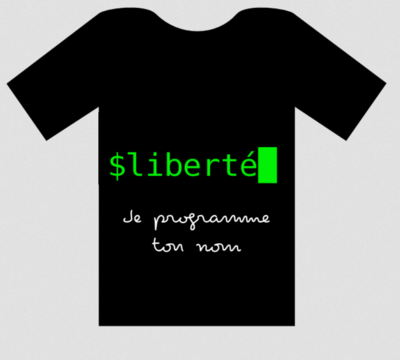
A partir du commentaire de Théo.
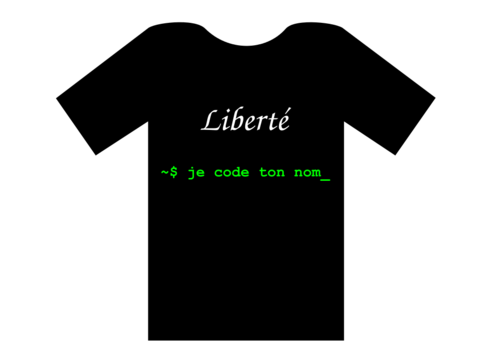
Source SVG: [1]
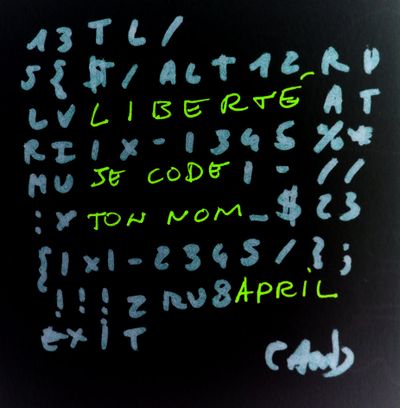
Reconditionnement de l’idée de Théo par Antoine (à finaliser).
Idéalement texte blanc remplacé par du code vraisemblable, même s'il n'est pas fonctionnel.
Propositions de code à intégrer au visuel d'Antoine
Proposition de PoluX
La fonction free dans malloc/memusage.c de la libc GNU.
Note pour les non geeks : ça permet de libèrer la mémoire allouée :-)
/* `free' replacement. We keep track of the memory usage if this is the
correct program. */
void
free (void *ptr)
{
struct header *real;
/* Determine real implementation if not already happened. */
if (__glibc_unlikely (initialized <= 0))
{
if (initialized == -1)
return;
me ();
}
/* If this is not the correct program just use the normal function. */
if (not_me)
{
(*freep) (ptr);
return;
}
/* `free (NULL)' has no effect. */
if (ptr == NULL)
{
catomic_increment (&calls[idx_free]);
return;
}
/* Determine the pointer to the header. */
real = ((struct header *) ptr) - 1;
if (real->magic != MAGIC)
{
/* This block wasn't allocated here. */
(*freep) (ptr);
return;
}
/* Keep track of number of calls. */
catomic_increment (&calls[idx_free]);
/* Keep track of total memory freed using `free'. */
catomic_add (&total[idx_free], real->length);
/* Update the allocation data and write out the records if necessary. */
update_data (NULL, 0, real->length);
/* Do the real work. */
(*freep) (real);
}
En version « compacte » :
~/glibc-2.27$ grep '^free (' malloc/memusage.c -B 3 -A 46 | tr '\n' ' ' | sed -e 's/[ ]\+/ /g' -e 's!/\*[^*]*\*/ !!g' | fold -w 35
void free (void *ptr) { struct head
er *real; if (__glibc_unlikely (ini
tialized <= 0)) { if (initialized =
= -1) return; me (); } if (not_me)
{ (*freep) (ptr); return; } if (ptr
== NULL) { catomic_increment (&cal
ls[idx_free]); return; } real = ((s
truct header *) ptr) - 1; if (real-
>magic != MAGIC) { (*freep) (ptr);
return; } catomic_increment (&calls
[idx_free]); catomic_add (&total[id
x_free], real->length); update_data
(NULL, 0, real->length); (*freep)
(real); }
Note : la première ligne c'est pas le code, c'est le code de compactage de François :)
Ça commence à "void".
Mise au propre propositions graphiques
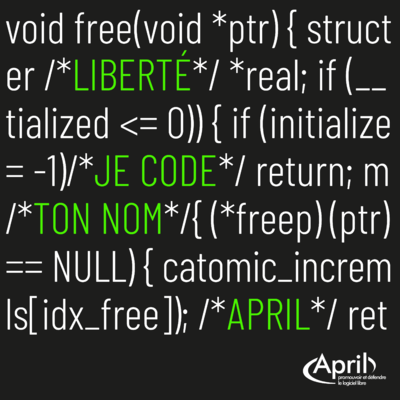
Version code. V1 (style de police light)
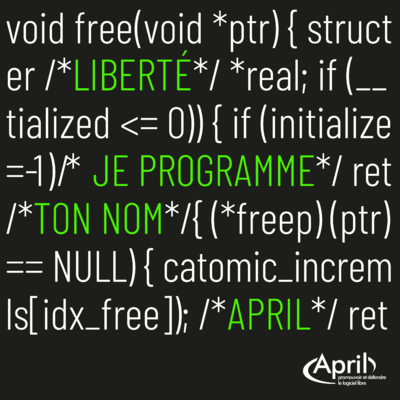
Version programme. V1 (style de police light)
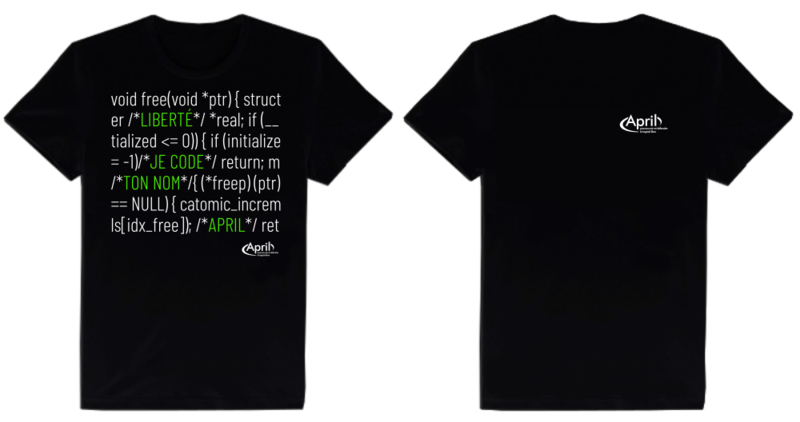
Simulation. V1 (style de police light)
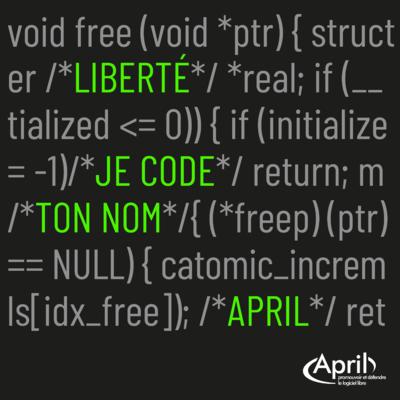
Version code. V2 (style de police regular)
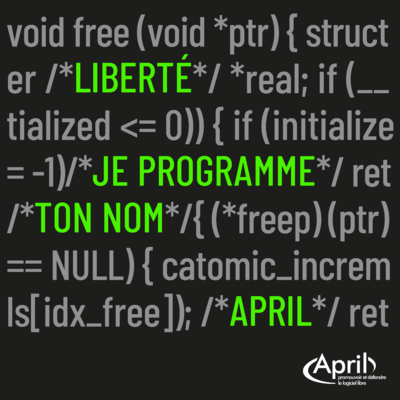
Version programme. V2 (style de police bold)
Couleur du tee-shirt
Idéalement noir, pour faire ressortir les couleurs blanc et vert fluo du visuel et donner l'illusion d'un terminal. Vert fluo, spécial RMLL.